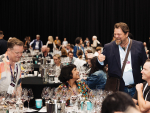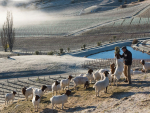If there was an over riding message to come out, it was no one can be complacent as the industry moves forward. From viruses to wood diseases, chemical resistance to yield estimations, clones and rootstocks to undervine management – the conference delved deep into what is important for growers.
But the big one to emerge on the last day was the potential of a bio security threat. Researchers are closely monitoring what the biggest threats are and why. For the first time this issue we take a look at the five big ones, what they are, what they could do and most importantly what they look like.
Having heard the consequences of Psa on the kiwifruit industry, the fear of what an unknown pest or disease could do to our wine industry was palpable throughout the room. Vigilance is ever important when it comes to preventing such a disaster. Especially given the majority of threats could arrive in New Zealand as a hitch hiker. In other words they could come in via aircraft holds, on ships, shipping containers and imported cars to mention just a few.
The wine industry needs to be pro active in preventing these threats. Hoping it won’t happen isn’t an option. As Peter Baines, the founder of Hands Across the Water said in his highly motivational speech, “Hope is not a plan!”
We are aware that the Glassy-winged sharpshooter which decimated Californian vineyards, has made its way to the Cook Islands. Given the high volume of traffic between there and New Zealand, the chances of it making its way to our shores are high.
But there are others including the Spotted-winged Drosophilia, the Brown Marmorated Stink Bug, the European Grapevine Moth and Vine Mealy Bug to name a few.
The cost of an incursion would be in the millions of dollars, NZW CEO Philip Gregan said. Any delay between discovering something strange in your vineyard and notifying experts, means the cost rises exponentially. Whether the industry could cope with such a financial burden remains to be seen.
Eradication may seem like the answer – but as New Zealand has learned from other countries, that’s an easy thing to talk about, not so easy to achieve.
So if nothing else this month, please take time to look at the major risks to New Zealand. Ensure your staff know what these pests look like and if you or them see anything faintly resembling them – ensure that you get in touch with the powers that be, whether that is MPI, NZWinegrowers or the Exotic Pest and Diseases Hotline.
On a completely different note, this month we also take a look at the lessons learned from the recent Marlborough earthquakes. While the damage was devastating for those wineries involved, it could have been far worse if the quake had been centred closer to Blenheim. A winery engineer who visited the region shortly after the August 16 event, says there were common themes in the damage and there are lessons for all wine regions to take from it. ν












